Growing indoor plants is the best way to create a pleasant and attractive environment in homes, offices, and other living spaces.
It can also be a satisfying endeavor for all gardening enthusiasts, beginners, or experts, alike! Usually, they grow best when planted in soil, but they can also be grown in water!
Most common indoor plants that grow in water are the African Violet, Arrowhead Plant, Begonia, Chinese Money Plant, Dracaena, English Ivy, Impatiens, Lucky Bamboo, Moth Orchid, Ornamental Sweet Potato, Paperwhite Plant, Sweetheart Hoya, Ti Plant, Wandering Jew, and more! There are a total of 27 great species.
To know more about indoor plants that can grow in water, their physical attributes, hardiness, and water requirements, simply read further this article!
How to Grow Plants in Water?
- Prepare the container, jar, or vase to be used. It should have a wide mouth big enough to fit the plant you’re going to propagate.
- Fill the container with water, preferably clean, room temperature water, reverse-osmosis water, or rainwater. Tap water can also be used, but it must be sit out overnight to let its chlorine content evaporate.
- Select your leaf or stem cuttings, then place them inside the container. The bottom node of the cutting should be submerged in the water, while the top node should be exposed to air.
- Depending on the species, you would have to wait some time between 1 to 3 weeks for the plant to start growing roots.
- When it develops a robust root system, you can choose to let it mature in water or transplant it into a new container with potting mix for better results.
27 Indoor Plants That Grow in Water
African Violet
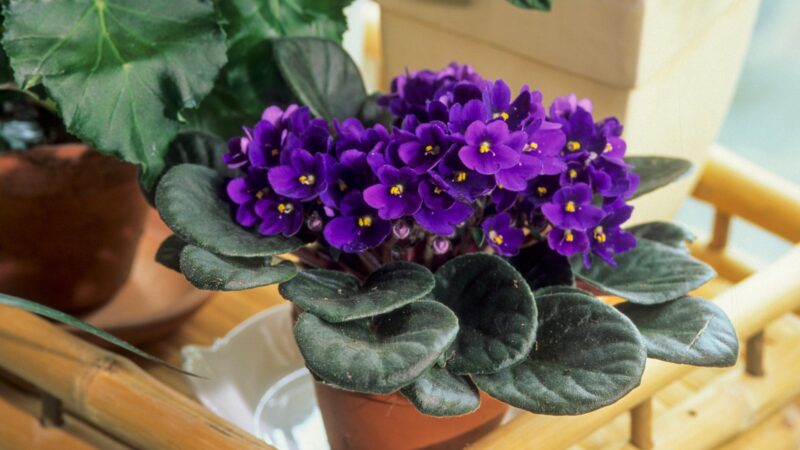
This is named after its violet-colored flowers. The African Violet is no longer only violet since it comes in various varieties and hybrids. They’re among the most popular houseplants due to being low maintenance and ability to bloom several times annually under the right environmental conditions.
- Scientific Name: Saintpaulia ionantha
- Appearance: Varies in appearance as the flower color can be white, pink, lavender, blue, violet, and reddish-violet and can be singular, double, semi-double, fringed, star-shaped, or ruffled. The leaves can be spidered, pointed, plain, quilted, ruffled, and scalloped. The entire plant can be in a mound, rosette, or round form.
- Hardiness: Grows well in warm temperatures of 65°F to 80°F and low light levels but cannot tolerate drought
- Size: Less than 8 inches (miniature), 8 to 16 inches (standard), more than 16 inches (large)
- Water requirements: The plant should always be sufficiently moist but not wet. Use distilled, room-temperature water, reverse-osmosis, or rainwater. Propagate by planting leaf cuttings into the water until roots begin to sprout. The leaf blade should be above water while its petiole faces the water.
Alocasia
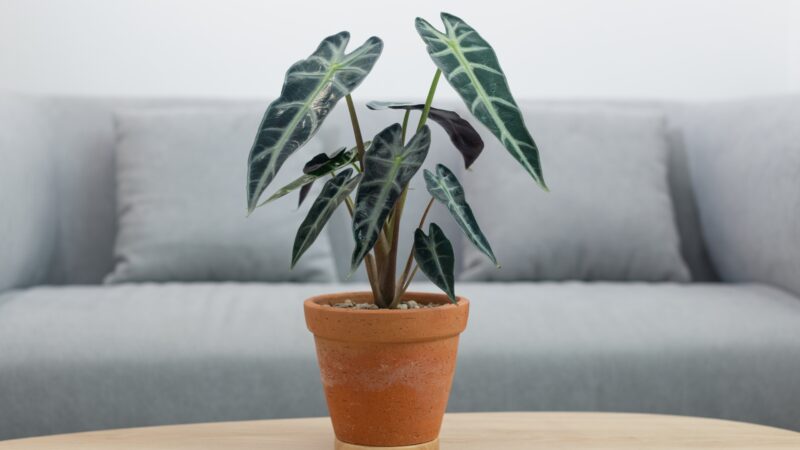
Alocasia is a genus that refers to a group of perennial plants that are native to tropical areas. They are known for their large, heart-shaped leaves. They can be used as accent plants in residential landscapes, ground cover, or edges for patios and walkways.
- Common Name: Elephant’s Ear
- Appearance: Characterized by large, shield-like, or arrow-like leaves that vary in color and variegation depending on the species.
- Hardiness: Grows in temperatures of 68°F and 77°F with partial shade. It does not do well with salt but is tolerant to flooding and has no major pest problems.
- Size: 8 inches to 9 feet
- Water requirements: Most varieties of elephant ears can be propagated in a few inches of standing water or as an emergent plant, which means it is still planted in soil, but the roots, not the entire plant, are submerged underwater. Avoid planting in or near a natural water source since they spread quickly and may become a nuisance.
Aluminum Plant
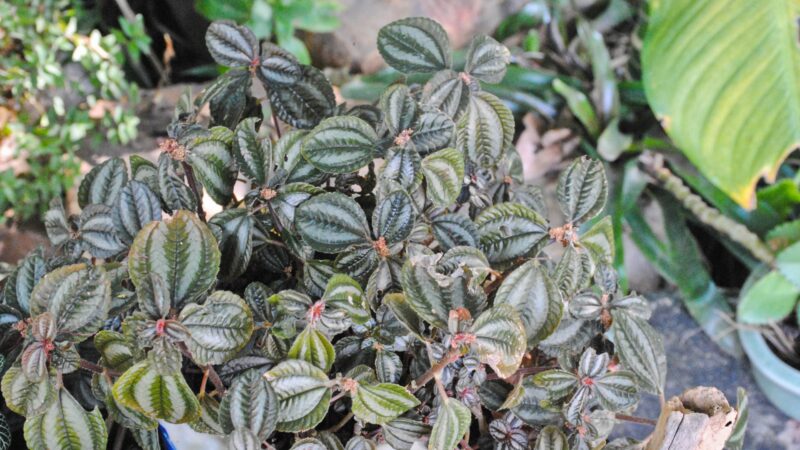
This herbaceous perennial is a popular interiorscape or container plant. But it can be an invasive plant in its native tropical environment. Its common name comes from its foliage which looks like it has been splashed with aluminum paint due to its silvery color. The Aluminum Plant is also referred to as the Watermelon Pilea due to its leaf appearance.
- Scientific Name: Pilea cadierei
- Appearance: A branched herb with slender, succulent stems, silver and toothed evergreen leaves with prominent veins, and tiny white flowers that come in clusters.
- Hardiness: Hardy to temperatures of 65 to 80°F and has an average tolerance towards heat. Grows best in shaded locations.
- Size: 6 to 15 inches
- Water requirements: Propagate using cuttings only with the stem submerged (not its foliage) into a clean source of room temperature water or collected rainwater. Roots should start forming within a week or two.
Arrowhead Plant
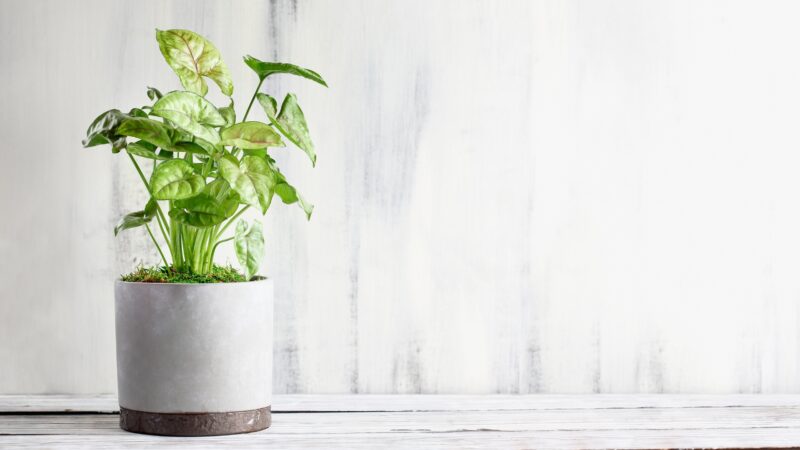
This is growing as a tropical perennial vine or shrub. The Arrowhead Plant is ideal for interior settings. It is the most typically produced species in the industry of foliage plants.
However, when it’s naturally grown outdoors or in its native forest environment, this plant is an invasive species that threatens endangered species of ferns.
- Scientific Name: Syngonium podophyllum
- Appearance: Has green, juvenile leaves that matured into arrow-shaped leaves and green flowers that grow on a spike. It exhibits a bush-like habit as evidenced by its climbing, trailing, or cascading stems.
- Hardiness: Tolerates temperatures of 60°F to 80°F, bright to partially shaded locations, and below-average humidity
- Size: 3 to 6 feet
- Water requirements: Plant stem cuttings in a large vase or glass jar filled with non-chlorinated water. At least 2 to 3 nodes of the cuttings should be submerged. The water should be high enough but shouldn’t be able to touch the foliage.
Begonia
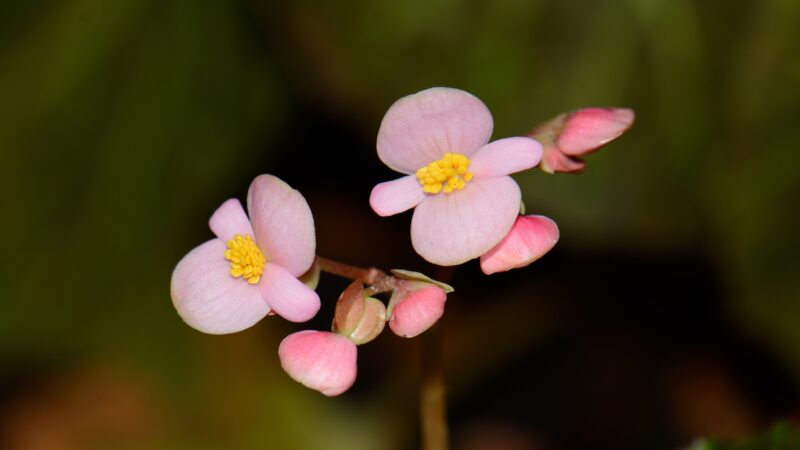
There are over 2,000 species of begonias worldwide and are commonly native to the tropics. They are used for their ornamental value and as bedding plants that can be grown in hanging baskets, window boxes, and other containers. There are 4 main types of begonias, namely, cane, wax, rhizomatous, and tuberous begonias.
- Scientific Name: Begonia L.
- Appearance: Varies per species, but they are generally a genus of forest understory plants with attractive foliage (brown, green, maroon, bronze) and flowers (white, red, yellow, pink, orange). Can also have a bushy habit, a single stalk, or anything in between.
- Hardiness: Thrives in temperatures of 60°F to 80°F under partial to full shade. Only a few cultivars can tolerate full sunlight exposure.
- Size: 6 inches to 2 feet
- Water requirements: Often propagated by leaf or stem cuttings placed. Water should be clean. If possible, use distilled water and not cold water or tap water that is concentrated with minerals.
Caladium
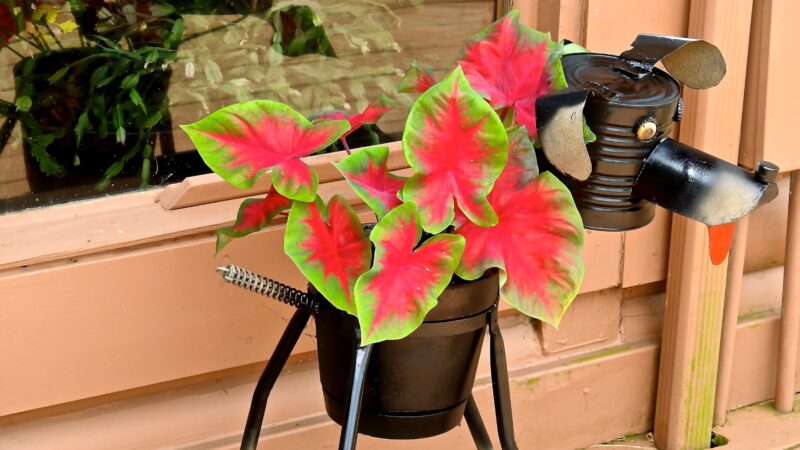
Ideally used in garden borders, containers, or as bedding plants due to their decorative, multicolored foliage, Caladiums refer to a genus of tropical plants that are characterized by heart-shaped leaves. It has more than 1,000 cultivars of varying colors and variegated combinations.
- Common Name: Angel Wings
- Appearance: Leaves can be a variety of colors depending on the species or cultivars, such as red, white, pink, and green, with contrasting borders, backgrounds, and colored midribs. Has no stems and rarely grows flowers.
- Hardiness: Grows best in dry locations with temperatures of 70°F to 75°F. Most cultivars are adapted to receiving full shade, but some may tolerate partial sunlight.
- Size: 12 to 30 inches
- Water requirements: Plant its tubers in glass vases or jars with clean, fresh, non-chlorinated water, lake or river water, or reverse-osmosis water, then place them in an area that is partial to fully shaded. Avoid using tap water unless you allow it to sit overnight.
Chinese Evergreen
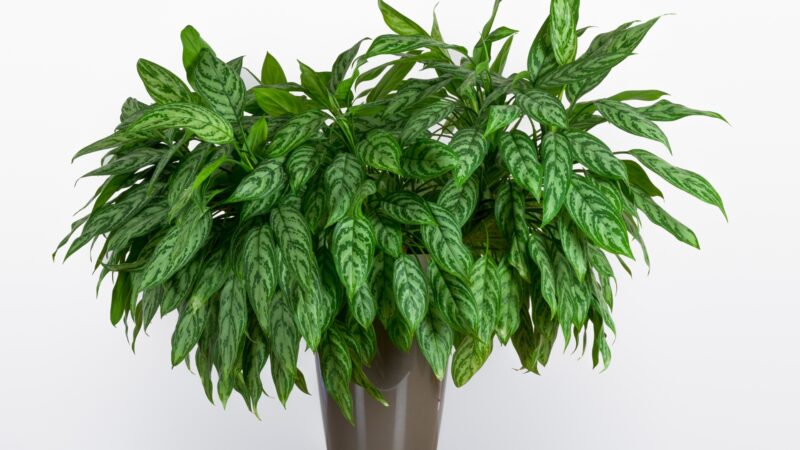
This is usually grown in shade gardens, beside patios, on walkways, in woodland settings, and as a houseplant in offices and homes. The Chinese Evergreen is an attractive plant by itself or in groups with other plans to create a coarse-textured, tropical effect in any locations they’re placed in. They’re best paired with white or warm-colored flowering plants.
- Scientific Name: Aglaonema commutatum
- Appearance: Erect and bushy shrub, dark green, lance-shaped leaves with grayish silver blotches found on the stems, green flowers, and red, fleshy berries
- Hardiness: Prefers temperatures of 60°F to 72°F with a humidity level of 60 to 70 percent. It can tolerate low light levels, drought, and even air conditioning.
- Size: 1 to 3 feet
- Water requirements: Propagate 6-inch stem cuttings into a glass, vase, or even simple cups of clean, filtered water on a windowsill. Watch out for any fluoride, salt, or chlorine-filled water since it can cause brown leaf tips.
Chinese Money Plant
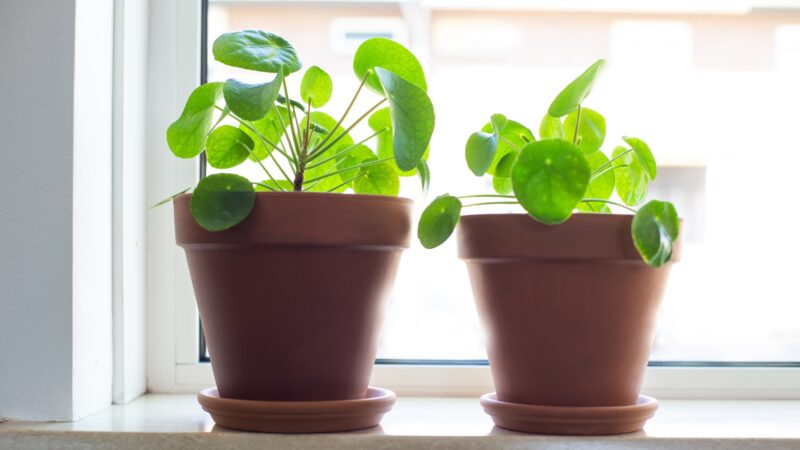
Great for a beginner’s hobby plant as it requires constant care with regular watering and frequent fertilization but is not too much of a hassle. The Chinese Money Plant consistently produces daughters from the mother plant, which can be easily removed using a knife and then propagated into a new pot.
- Scientific Name: Pilea peperomioides
- Appearance: Has shiny, rounded leaves that are attached to its thin stems so closely it appears that the leaves are floating in mid-air.
- Hardiness: Hardy to temperatures of 55°F to 85°F and is resistant to drought but intolerant to cold temperatures. It doesn’t have any humidity requirements.
- Size: Up to 12 inches
- Water requirements: Propagate the plant in clean water and make sure to replace the water every week if you intend to let it mature in water or every month if you transplant it into a container with potting mix. Tie a paper towel or any thin fabric loosely around the plant’s stems to reduce evaporation.
Coleus
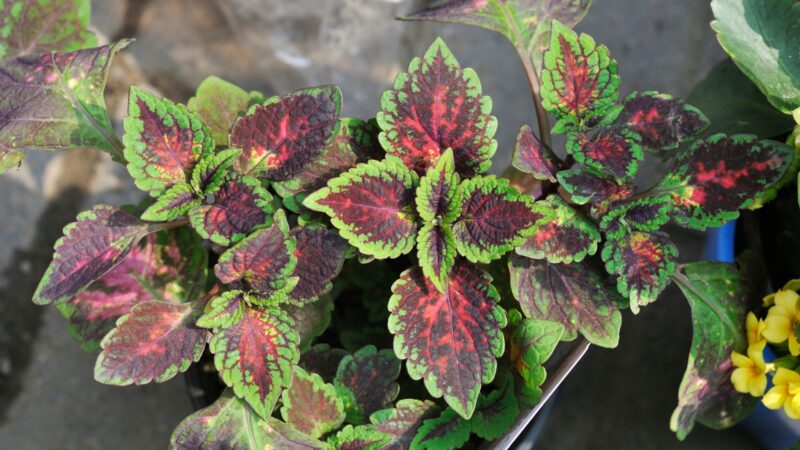
Historically, Coleus plants were popular in Victorian-era gardens. Unlike most annuals, these plants are usually prized for their striking foliage instead of the typical flowers.
It is easy to grow and hard to kill. They can be grown in landscape beds as well as in containers such as hanging baskets or pots placed in patios, shady spots, garden terraces, and porches.
- Common Name: Painted Nettle
- Appearance: Herbaceous shrub that has opposite leaves, which may be a combination of maroon, red, pink, yellow, green, and rust, square and semi-woody stems, bluish-white flowers, and brown fruits
- Hardiness: Hardy to temperatures between 60°F to 75°F and is highly sensitive to the cold
- Size: 0.5 to 3.5 feet
- Water requirements: These plants are susceptible to algae when grown in water containing fluoride or chlorine. As such, using bottled or distilled water is necessary. However, if only tap water is available, make sure to sit it out overnight to let the chlorine evaporate.
Croton
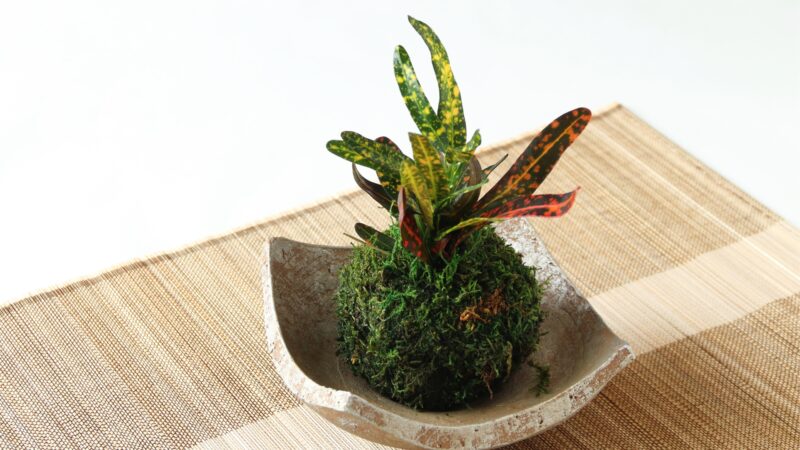
This tropical evergreen perennial is a popular decorative indoor plant for its multicolored and fantastically marked foliage. But it can also be used as a specimen plant, exterior foundation plant, and hedge. Homeowners and gardeners should keep Crotons out of reach of pets and children since the leaves have irritating and poisonous qualities.
- Scientific Name: Codiaeum variegatum
- Appearance: A bushy, branching shrub that has large, leathery leaves and is variable in shape (may be oval, linear, wavy, or spiral) and color (ranging from white, pink, red, orange, yellow, or purple). Shoots or sports that look completely different from the plant may appear.
- Hardiness: Prefers warm conditions of 60°F to 80°F. It is not tolerant to extreme heat and cold temperatures below 55°F.
- Size: 3 to 10 feet
- Water requirements: Placing cuttings in unchlorinated water with a temperature of 68°F to 77°F will give the best results. Once it produces its root system, transfer it to a container with soil potting mix for it to become a full-fledged plant.
Dracaena
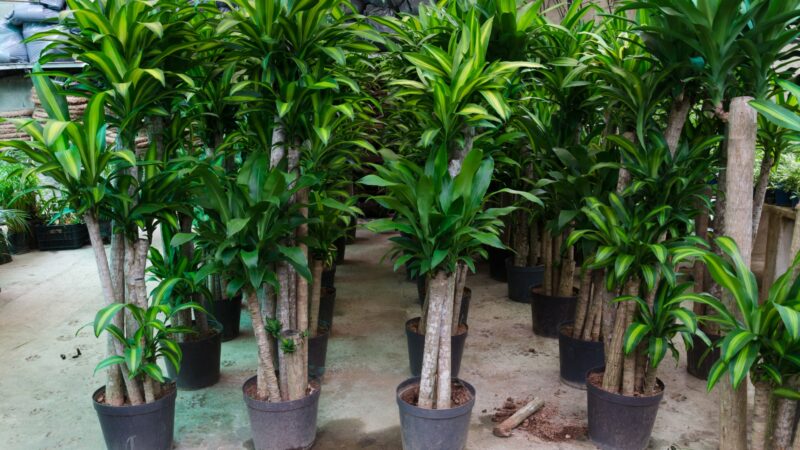
Dracaena is a genus of houseplants used for both office and home plantings due to their robust, tropical appearance. Named after the ancient Greek word drakaina, which means female dragon, certain species of this genus secrete a reddish resin when the leaves or bark are cut. Currently, there are 120 species of succulent shrubs and trees of Dracaena.
- Common Name: Depends on the species
- Appearance: Upright shrub or tree with broad, evergreen leaves varying from green to grayish green and with a variety of striped patterns depending on the cultivar.
- Hardiness: Highly durable plants as they can tolerate poor light, dryness (but not excessively), low humidity, and drought.
- Size: 2 to 10 feet
- Water requirements: Place 6 to 10-inch cutting in clean, unchlorinated water and wait for a few weeks for its roots to grow. If they reach an inch in length, repot them in another container. Take note that Dracaenas are sensitive to fluoride, so when using tap water, leave it overnight or use rainwater instead.
English Ivy
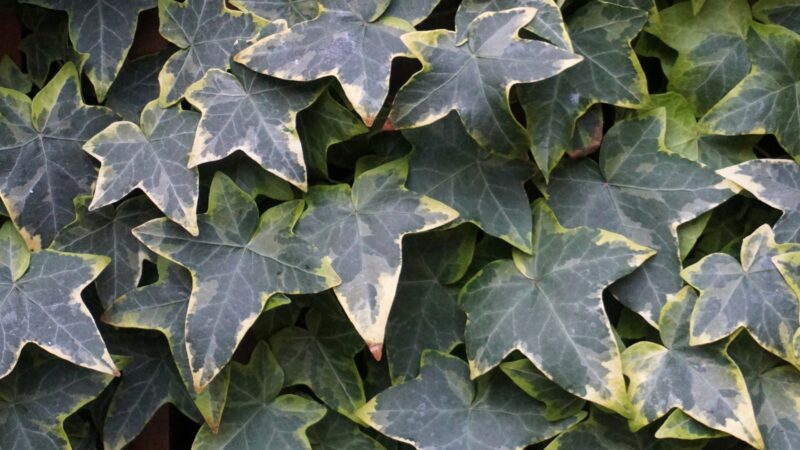
The English Ivy is an evergreen, versatile indoor plant that can be grown in pots, hanging baskets, wire topiaries, and trellis frames. They spread easily and quickly, which makes regular pruning necessary to maintain their size and shape. It is difficult to grow them outdoors as they are highly invasive.
- Scientific Name: Hedera helix L.
- Appearance: Has waxy, dark green, spade-shaped leaves with white or pale green veins, thick and woody stems, small and inconspicuous flowers, and black to dark blue fruits.
- Hardiness: Does well at room temperatures of 40°F to 70°F, moderate humidity, and tolerant to drought and frost.
- Size: 6 to 8 inches but can reach up to 100 feet
- Water requirements: Place stem cuttings into clean water. If possible, use distilled water. When using tap water, let it sit out overnight on top of a table or kitchen work surface before planting to let any chlorine evaporate. Change the water once a week or when it starts looking dirty.
Impatiens
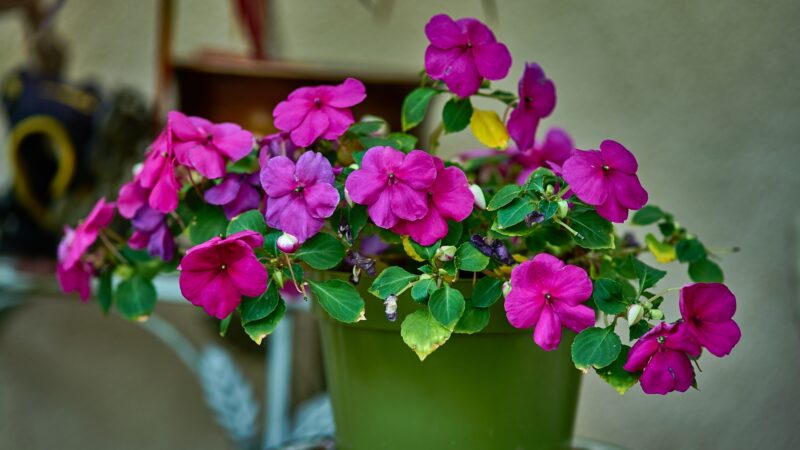
It is a low-maintenance, brightly colored group of flowering plants native to the tropical regions of Asia and Africa. They are often planted in containers, borders, and hanging baskets.
Their name is of Latin origin which refers to the way their seed capsules burst, shooting seeds out. They are known for several common names, depending on geographical location and species.
- Common Names: Jewelweed, Balsam, Busy Lizzie, Touch-Me-Not
- Appearance: Upright cushion, clump, or mound-shaped foliage of medium green color or green tinted with bronze and flowers that come in various colors such as pink, red, orange, white, and violet.
- Hardiness: Hardy to temperatures of 70°F to 75°F and partially-shaded to fully-shaded areas, as well as average relative humidity.
- Size: 0.5 to 2.5 feet
- Water requirements: Remove any lower leaves on the cuttings then place them in a vase or glass of clean, unchlorinated water. Submerge the first few nodes of the cuttings. They can also be propagated in marginal ponds.
Lucky Bamboo
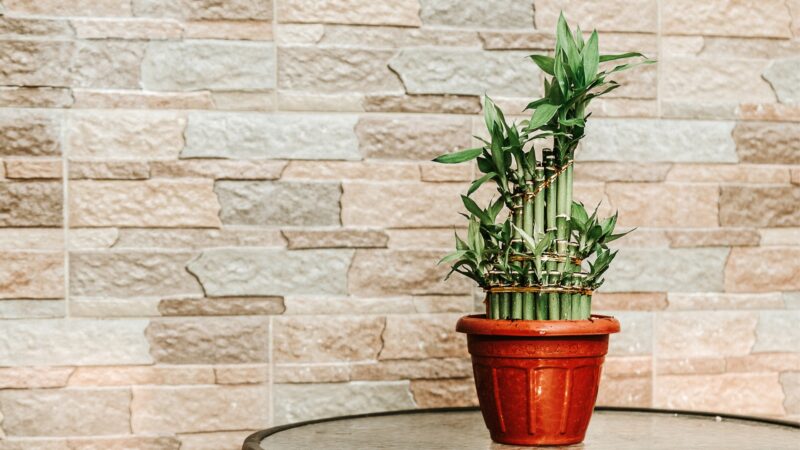
This is known to be a symbol of good fortune and prosperity in Asia. It is believed that the Lucky Bamboo attracts good health, luck, and love to whoever possesses the plant.
It makes a great indoor plant for homes and offices, as well as a great addition to zen and minimalist gardens. This plant is extremely low maintenance as it can survive on water alone.
- Scientific Name: Dracaena sanderiana
- Appearance: Slender yet hardy shrub with flexible, strap-shaped leaves, green and simple or branched stems, and cream or off-white flowers
- Hardiness: Prefers warm temperatures of 65°F to 90°F, partially-shaded areas, and above-average humidity.
- Size: 1 to 8 feet
- Water requirements: This plant is commonly grown hydroponically in water vases, with leaf or stem cuttings planted in distilled or purified water. Avoid using bottled water since it may create a build-up of minerals or salt in the plant’s container in the long run.
Mint
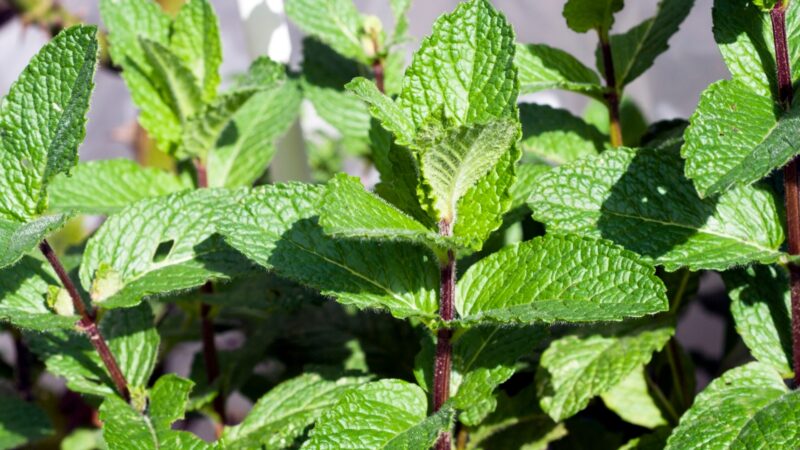
Mint plants belong to the genus Mentha and currently consist of approximately 20 species. They are rapidly-growing, aromatic herbs typically grown for their leaves which are used as a flavoring and for medicinal purposes.
They become quite invasive if left unattended. This is why it is advised to plant them in containers instead of in-ground.
- Scientific Name: Mentha L.
- Appearance: Have upright and branching stems, oppositely-arranged leaves that are oblong, lanceolate, or ovate in shape and covered in tiny hairs with margins that are serrated, and flowers that are purple or white in color.
- Hardiness: Thrive in temperatures of 55°F to 70°F, full sun exposure or partial shade, depending on the species, and are generally not tolerant to frost.
- Size: 1 to 3 feet
- Water requirements: Place stem cuttings, remove lower leaves and prop them on a glass of clean water. The water should regularly be changed every 5 to 7 days to maintain cleanliness. The mint plant can also be stored in the refrigerator as long as there is a plastic bag tied loosely on top of the leaves.
Monstera
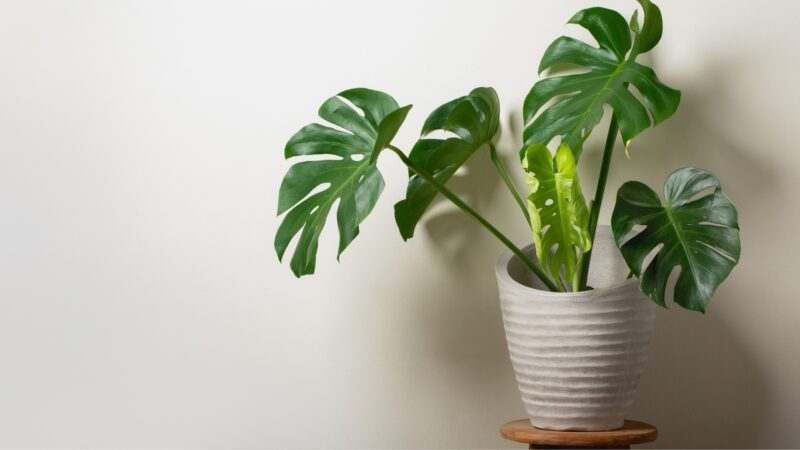
Despite its common name, the Monstera is not a philodendron but is, instead, a perennial, woody climbing vine. It grows as a tall, sturdy tree in its geographic range from Mexico to Panama but is commonly grown as a houseplant in home environments. Most of its varieties are available in shops that sell tropical houseplants.
- Common Names: Split-leaf Philodendron, Swiss Cheese Plant
- Appearance: Has pinnately-lobed leaves that are ovate or cordate in shape and glossy green in color. It also grows fruits and flowers but not when grown as a houseplant.
- Hardiness: Grows best in above-average relative humidity and temperatures between 65°F to 85°F but can survive temperatures as low as 50°F.
- Size: 10 to 15 feet (indoors), up to 30 feet (outdoors)
- Water requirements: Propagate stem cuttings in clean, filtered water. A balanced liquid fertilizer should be added to its container once a month.
Moth Orchid
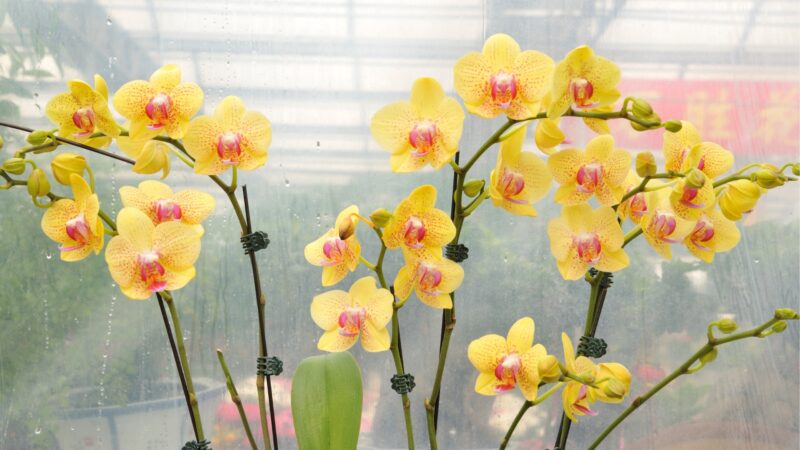
The popularity and allure of the orchid family are largely attributed to the beauty, reasonable price, and mass production of moth orchids. They are readily available in gardening stores and come in a variety of hybrids that are easy to grow and maintain. These plants can reduce the amount of volatile organic compounds (VOCs) in the air.
- Scientific Name: Phalaenopsis spp.
- Appearance: Grows broad and leathery leaves, as well as three-lobed flowers shaped like a moth and can be purple, yellow, orange, white, or pink in color.
- Hardiness: Hardy to daytime temperatures of 70°F to 80°F and nighttime temperatures of 55°F to 70°F. Unlike most plants, it can survive overwatering and is very tolerant to drought.
- Size: Up to 8 inches
- Water requirements: Plant moth orchids at room temperature, distilled water, or rainwater. Tap water is alright, but it must sit out overnight before planting. Afterwards, you can leave the orchids in the water and regularly change the water every week or two until it grows.
Ornamental Sweet Potato
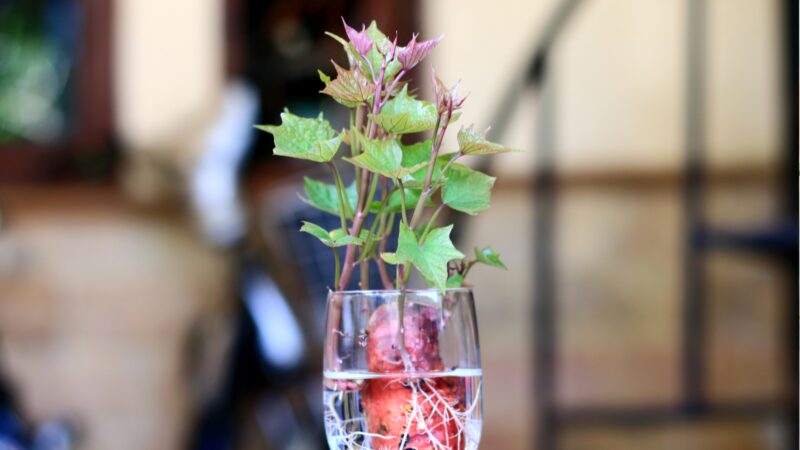
A bold, tropical plant with foliage that is much more vibrant than edible sweet potatoes, the Ornamental Sweet Potato is popularly grown in containers and garden beds as well as around edges and as a groundcover. It can be treated as both annuals and perennials as they come in several varieties.
- Scientific Name: Ipomoea batatas
- Appearance: Creeping vine with heart-shaped leaves that range from bright chartreuse green to dark purple, lavender, or white flowers and tubers that can be white, red, purple, brown, or yellow in coloration
- Hardiness: Needs full sunlight exposure for best plant growth and thrives in temperatures above 55°F. As such, it is resistant to heat and drought.
- Size: 8 inches to 13 feet
- Water requirements: Place the plant inside a container of clean, unchlorinated water. The top one-third of the potato should be exposed by staking it using toothpicks, while its pointed end should be submerged in the water.
Paperwhite Plant
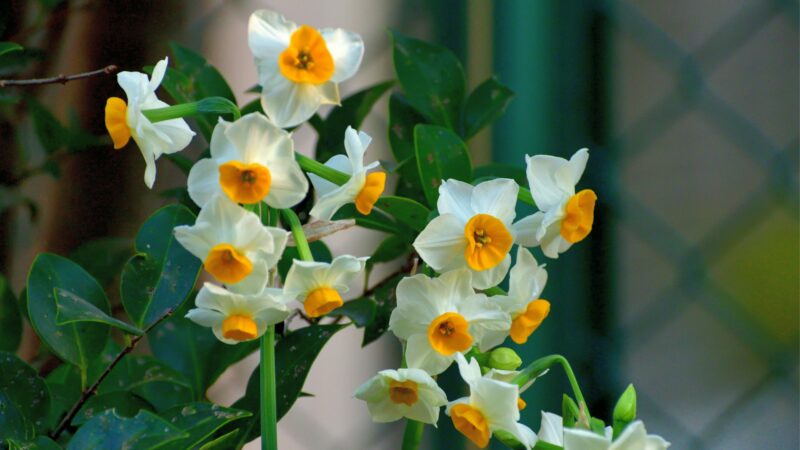
Also called the Paperwhite Narcissus, this plant is a perfect holiday gift when you’re looking for bulbs that can be forced to bloom flowers and come with a heavenly fragrance. They don’t require any chilling before allowing it to flower, which makes it easy for gardeners with less experience or with no time to spare to grow them.
- Scientific Name: Narcissus tazetta
- Appearance: Has flat leaves and small, clustered flowers that are orange, yellow, or white in color
- Hardiness: Tolerant to temperatures of 60°F to 70°F as well as heat and drought but not too extremely wet conditions
- Size: 10 to 18 inches
- Water requirements: Paperwhite bulbs can be propagated in a shallow glass jar, vase, or bowl with clean water. The water should not be in contact with the bulbs, only at the bottom of them, or else they will rot.
Philodendron
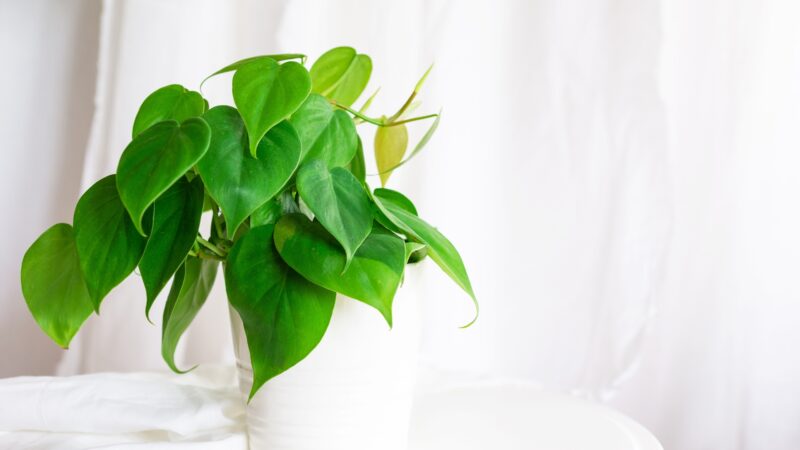
Philodendron refers to a genus of large, tropical plants and is divided into two types: climbing and non-climbing. Climbing types are great for growing in a hanging basket, on a moss pole, and on a trellis, while non-climbing types, also referred to as self-heading, are great for landscape use since they consume a great amount of space.
- Scientific Name: Philodendron Spp.
- Appearance: Varies in size of foliage, but they generally have glossy, leathery, or velvety heart-shaped leaves that are solid green in color. Depending on the species, they may have trailing stems.
- Hardiness: Grows best in day temperatures of 75°F to 85°F and night temperatures of 65°F to 70°F. It is fairly drought-tolerant.
- Size: 1 to 20 feet
- Water requirements: This plant is one of the few species that can grow permanently in water without needing to repot. However, they won’t reach their full potential. Simply place cuttings inside clean, chlorine-free water.
Pothos Plant
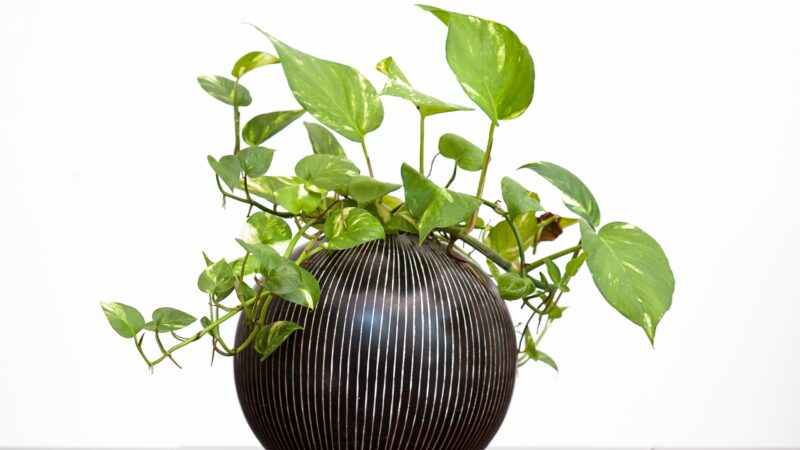
Also referred to as the Devil’s Ivy, the Pothos is one of the most popular indoor plants in North America, commonly planted in hanging baskets, trained on a sphagnum or foam pole, or used as an underplanting for large potted trees or plants. It is also able to remove pollutants such as benzene, formaldehyde, and xylene.
- Scientific Name: Epipremnum pinnatum
- Appearance: Evergreen vine with a branching and slender twining vine as well as glossy and heart-shaped leaves that are either bright green in color or splotched with cream or yellow.
- Hardiness: Hardy in temperatures between 70°F to 90°F and high humidity but is not tolerant to direct sunlight and drafts.
- Size: Up to 10 feet (indoors), up to 60 feet (outdoors)
- Water requirements: Propagate using cuttings and place in a vase or jar with clean, chlorine-free water. Only one or two nodes should be submerged in water. Roots begin to form around 1 to 2 weeks.
Prayer Plant
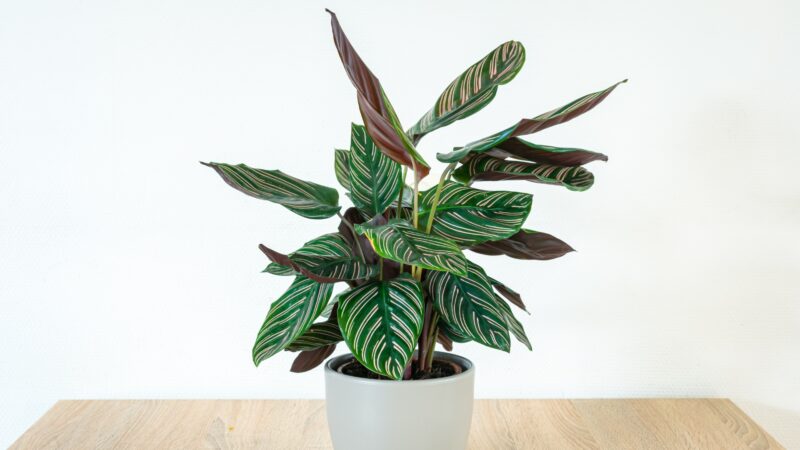
Named after the behavior of its leaves—spread during the day, closed or folded in the evening resembling praying hands, the Prayer Plant is a small, tropical plant typically grown as a houseplant in temperate regions. They can be used as hanging plants, small specimen plants, and groundcovers and planted in combination planters and dish gardens.
- Scientific Name: Maranta leuconeura
- Appearance: Spreading perennial that forms low-growing clumps and has coarse-textured, oval-shaped leaves with dark variegations and reddish or pale undersides.
- Hardiness: Thrives in warm temperatures between 60°F and 85°F with high humidity and bright but indirect light.
- Size: 8 to 12 inches
- Water requirements: Prop the plant’s cuttings in clean, chlorine-free room temperature water with only the nodes submerged in water. If the plant is under environmental conditions that aren’t ideal, cover it using a plastic bag. Water should be changed every 2 days or when the water starts getting dirty.
Purple Heart Plant
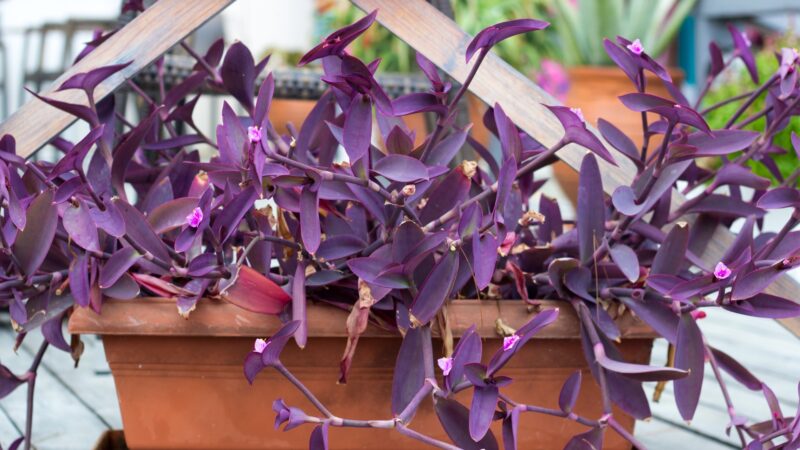
The Purple Heart, also called the Purple Queen, is a widely available and popular plant due to its stunning foliage and delicate yet attractive flowers. It belongs to the spiderwort family and is a training perennial best for rock gardens, mass planting, and for cascading in baskets or over walls. Despite being an aggressive grower, it is not considered an invasive plant.
- Scientific Name: Tradescantia pallida
- Appearance: Has lance-shaped leaves that are dark purple, fleshy and fragile stems, and inconspicuous pale purple or pink flowers.
- Hardiness: Best grew in temperatures ranging from 60°F to 80°F but can survive colder temperatures of 40°F. They are drought-tolerant and can survive even when neglected.
- Size: 12 to 18 inches
- Water requirements: Take a stem cutting, then dip the end in rooting hormone before placing it in a vase of room temperature water. Tap water is allowed as long as it has been sat out overnight.
Spider Plant
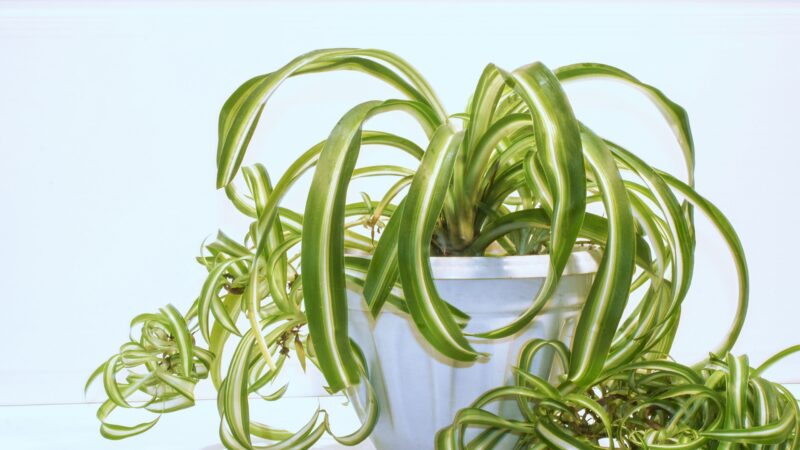
Native to the coastal regions of South Africa, the Spider Plant gets its name from the small plantlets that are produced on its long trailing stems, resembling spiders. It effectively absorbs chemicals, such as carbon monoxide, formaldehyde, and xylene, in the air in offices and homes. It’s best planted in a hanging basket or containers together with other foliage-type plants.
- Scientific Name: Chlorophytum comosum
- Appearance: Herbaceous plant that forms clumps, has strap-shaped leaves that are solid green or variegated with yellow or white stripes, thick and fleshy roots, small plantlets, and white, star-shaped flowers.
- Hardiness: Tolerant of neglect and is capable of thriving in virtually any environmental conditions, such as temperatures as low as 35°F and as high as 90°F.
- Size: Up to 3 feet
- Water requirements: Place offsets or cuttings in water that has been demineralized or in tap water that was allowed to sit overnight. The leaves should be growing outside of the water.
Sweetheart Hoya
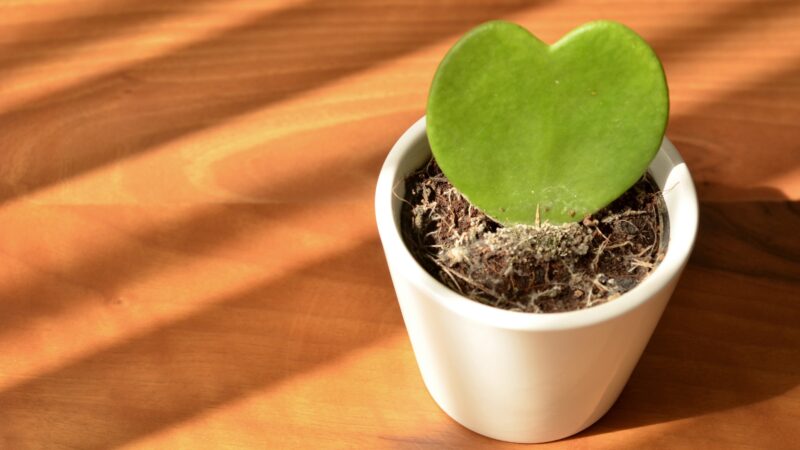
A member of the Hoya family consisting of plants with waxy leaves or porcelain flowers, the Sweetheart Hoya is a slow-growing houseplant with stunning blooms and a fragrance that is not too overpowering. Also referred to as the Lucky Heart, it is usually used as a Valentine’s Day gift to significant others due to its heart-shaped leaves.
- Scientific Name: Hoya kerrii
- Appearance: A succulent vine with red flowers that form clusters, a whitish corolla, and waxy, heart-shaped leaves.
- Hardiness: Thrives in temperatures ranging from 65°F to 80°F, is relatively drought-tolerant, and needs a maximum of 2 hours of light daily.
- Size: Up to 10 feet
- Water requirements: Propagate using stem cuttings in filtered or demineralized water. The top node and its leaves should be placed above the rim, while the bottom node should be submerged in the water.
Ti Plant
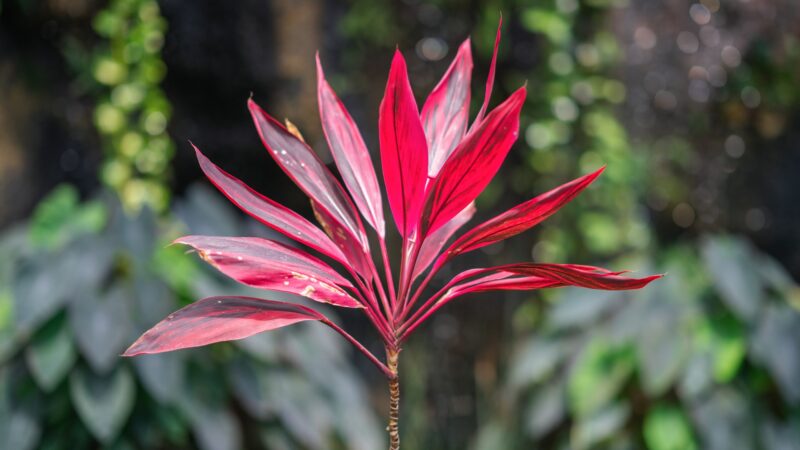
An indoor plant that makes an exciting addition to any landscape due to its tropical appearance, the Ti Plant is readily available in garden shops and plant nurseries. Botanists previously believed that it belonged in the lily family but is later categorized as a member of the agave family instead. It is also known as the Luck Plant and is often confused with Dracaenas.
- Scientific Name: Cordyline fruticosa
- Appearance: Tropical shrub characterized by having smooth, flexible leaves that can be deep red, pale pink, green, or purple in color. It grows yellow flowers and a red, fleshy, and rounded fruit.
- Hardiness: Hardy to temperatures of 60°F to 85°F but can tolerate 50°F and above-average humidity. The plant thrives best in full sun or partial shade.
- Size: Up to 13 feet
- Water requirements: This plant is particularly sensitive to fluoride so its cuttings must be propagated in distilled water. Rainwater can work too, as long as there have been no occurrences of acid rain in your area.
Wandering Jew
Also called the Zebra Plant and Inch Plant, the Wandering Jew is a famous houseplant that belongs to the spiderwort family. It is the ideal plant for any gardener, particularly those who lack experience since it is sturdy against almost any indoor environmental conditions. It can be grown as a groundcover or in hanging baskets and interiorscapes.
- Scientific Name: Tradescantia zebrina
- Appearance: Has purplish green leaves with purple and silver-striped undersides, succulent stems, inconspicuous boat-shaped and rose-pink flowers, and a fragile stem.
- Hardiness: Tolerates warm temperatures ranging between 60°F to 80°F, high humidity, heavy pinching and pruning, and bright light when grown indoors.
- Size: 6 to 9 inches
- Water requirements: Cut off any leggy growth on the plant and propagate in a jar or glass of clean, unchlorinated water. The bottom leaf node should be submerged, while the top leaf node should be exposed to air.